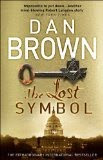
I’d read a couple of Dan Brown books years ago before they become nearly as common as copies of Harry Potter on the London Underground. The cryptographic basis behind Digital Fortress appealed to my inner mathematician (and geek), and Deception Point
fitted into the illusive category of fiction set in the Arctic Circle or the South Pole.
The Lost Symbol follows its central character Robert Langdon through an gruelling 12 hour period as he flies to Washington DC to deliver a lecture at the invitation of his friend Peter Solomon (a very senior Mason) and works through the consequences of the lecture not actually existing.
Cue lots of running around, small keys, big old keys, swipe cards, secret collapsing wooden boxes, holographic hard drives, conveyor belts, underground tunnels, boiling pyramids, libraries, deep and dusty vaults, tall towers and lots of details you didn’t know about landmarks that you’ve heard of. Oh, and the outing of some family secrets. Like Jack Bauer in 24, Langdon doesn’t eat and never stops for loo breaks!
It’s a one man conglomeration of fact and fantastical story bound together in a 670 page paperback that will take you two long evenings to read. (Could have been 666 if they’d dropped a couple of blank pages at the start!)
Brown’s eye for detail and trivia about buildings and societies, together with his obvious research into Masonic organisation forces the reader to either soak in the detail and become a fellow world expert in the intricacies of Washington DC, or else to switch into speed reading mode and turn the pages quickly to find the next bit of plot.
Dan Brown will never win the Booker Prize. The well balanced, poetic prose function is missing from his word processor. In fact, at the pace that the book reads, I do wonder how many keyboards he wrecks as he furiously hammers out the story on his computer.
But his fiction has a very particular style. As I waded through the first few chapters, building up speed, it felt like he was plaiting the story together. There’s a constant switching between the main characters, jumping back to their past before binding two characters together for a while and then handing over to someone new who needs to be woven into the messy creation.
The only author I know who comes close to Brown's style is Stephen Brown whose three books I received as brilliant Christmas presents in 2009. Agents and Dealers, The Marketing Code
and The Lost Logo
feature the little-known University of Hustler and as well as the most outrageous plots featuring secret societies, paramilitaries and Ireland’s less well known history. I’ll review this superb marketing and management thriller trilogy written by a Professor of Marketing Research at the University of Ulster when I finish the third book later this year.
While The Lost Symbol story revels in the intricate details of Freemason symbols, rituals and tradition, Brown is in no way anti-Masonic. In many ways his novel will probably do more to open dispel some of the more extreme conspiracy theories that circulate at yet simultaneously re-emphasises the deep loyalty between members of the “secret society”.
The book’s final page includes “the words of a great prophet”:
Nothing is hidden that will not be made known; nothing is secret that will not come to light.
While describing what happens if Dan Brown comes to your city to research his next novel, they’re also the words of Jesus, found in Luke 8:17!
The Lost Symbol is brought to you by the number 33.
And without wanting to be pedantic – or contradicted – I think Brown makes an error near the end of chapter 115 when he refers to a “labyrinth” when he really means a “maze” … as explained on Woman’s Hour last week.
No comments:
Post a Comment